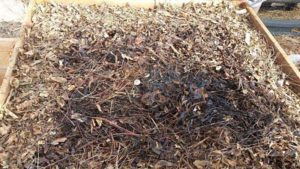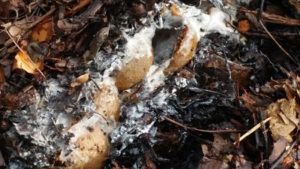Soil Recipe: Hot Composting for Cool Folks
by Guest blogger: Sarah Botwala-Messina
of Inika
Listen to her podcast HERE
We think composting is just like cooking a special dish. The tools, ingredients and techniques deserve attention. And it takes time, love and patience.
 The only difference is that in composting the role of ‘chef’ is played by gazillions of micro-organisms who enter and exit at the right time adding their unique flavor profile to the resulting stew. You, the composter, are the prep cook. Follow the lead, play your role then step back and watch. Compost happens!
The only difference is that in composting the role of ‘chef’ is played by gazillions of micro-organisms who enter and exit at the right time adding their unique flavor profile to the resulting stew. You, the composter, are the prep cook. Follow the lead, play your role then step back and watch. Compost happens!TOOLS YOU’LL NEED
- SCRAP COLLECTION PAIL
- COMPOST BIN
- PITCHFORK OR MANURE FORK
Optional:
- Wheelbarrow
- Sifter
- Thermometer
Place your scrap collection pail. Near the sink or next to the trash bin are great spots to catch compostables before they go into trash. Any plastic or glass container will work as a collection pail. Make sure it has a broad neck and a lid.
There are many kinds of compost bins. The most popular are the Soil Saver and the Compost Tumbler. Check if your city offers a discounted compost bin program. We recommend selecting a compost bin that sits directly on the ground.
Our favorite compost bin is the SmartStack. It is resilient, multi-talented and Instagram-worthy just like the modern urban composter for whom its made for. You can purchase it here or build it yourself using this design plan written by our awesome friends at Wild Willow Farm.
You will also need a pitchfork. We are talking about the kinds which have slightly curved and sharp tines. Truper Pro is our favorite.
INGREDIENTS
- *BROWNS
- GREENS
- WATER
- OXYGEN
Browns are materials rich in carbon. Finely chipped mulch from a tree trimmer, loads of dry leaves or shredded straw make good browns.
Greens are materials rich in nitrogen. Vegetative kitchen scraps, coffee grounds (even through they are brown in color), eggshells and grain based items make good greens.
The beneficial microorganisms that break down your foodscraps also need water and oxygen.
Stop by a community compost hub during work hours if you are in the San Diego area and help yourself to quality mulch. While you are there get a few scoops of our already in process compost (compost starter) which will give your pile a head start with beneficial microorganisms.
METHOD- LASAGNA LAYERS
Select a dirt spot in your backyard. Do not place your compost bin over concrete. We recommend selecting a site that has enough room to place two of your selected compost bins and you’ll see why in a bit.
Place a hardware cloth cut to the size of the bottom of your bin to deter pests and rodents from digging into your compost pile. The bottom frame of the SmartStack is prebuilt with a screen.
Start with 6-12 inches of carbon or browns. Just throw them into the bin by the handful or using a shovel.
Then add your greens or food scraps from your scrap collection pail. This is your green layer.
Now add the same quantity of carbon or browns to cover your greens or food scraps. We recommend hydrating your mulch before adding it to the bin. Simply soak the required quantity of mulch in a bucket or wheelbarrow for 10 to 15 minutes before you throw it on top of your greens.
Put the lid on the bin.
Repeat steps 2-4 until you compost bin fills up. An individual living by him/herself may take a full year to fill up their compost bin. For a family of 4 this may take anywhere from 3-6 months.
SERVING
- TURNING
- SIFTING
 When your compost bin is full you should give it a turn. Turning means sticking your pitchfork into the pile and transferring over the material from your bin into another container or in an adjacent spot. This is when you pile gets a boost of oxygen.
When your compost bin is full you should give it a turn. Turning means sticking your pitchfork into the pile and transferring over the material from your bin into another container or in an adjacent spot. This is when you pile gets a boost of oxygen.
It would be best to purchase another compost bin to turn your pile into. Geobins make a cost-effective turning bin. Or cut out the bottom of a trash bin and use that to hold your turned pile. The SmartStack will allow you to reconfigure the frames so you can have 2 bins – one to keep adding your fresh scraps into and the other to hold your turned pile.
As you keep turning and get to the bottom half of the bin you will see a dark brown, rich and crumbly material. This is compost. It will smell earthy. You can sift it to remove the bigger chunkier pieces of mulch or use it as is in your garden bed or around plants and containers.
At this point you will see that roughly a quarter or half of the contents of your turned pile will already have turned into compost. Leave the rest of your turned compost pile for a few months to completely break down.
Continue adding fresh scraps to your main bin and build your second batch of compost.
If you are in our area, stop by our community compost hubs for a demo, instructions, advice, troubleshooting and mulch. We want to make sure you succeed in this journey.
UrbanFarm.org/sarahshotcompost
About this author:
 Sarah is the executive director of Inika Small Earth, a nonprofit that started Food2Soil where they train interns in good composting techniques. Food2Soil collects vegetative food scraps from local restaurants then composts the scraps at two urban farms in San Diego, selling the finished product to local gardeners looking for high-nutrient soil.
Sarah is the executive director of Inika Small Earth, a nonprofit that started Food2Soil where they train interns in good composting techniques. Food2Soil collects vegetative food scraps from local restaurants then composts the scraps at two urban farms in San Diego, selling the finished product to local gardeners looking for high-nutrient soil.
Inika Small Earth is a charitable organization working to enhance the network of community composting hubs across San Diego. Their aim is to build the collective capacity to transform food scraps into soil and jobs for the community.
How to reach Sarah:
Website: www.food2soil.net
Facebook: @food2soil
Instagram: @food2soil
Email: info@food2soil.net
*Disclosure:
Some of the links in our podcast show notes and blog posts are affiliate links and if you go through them to make a purchase, we will earn a nominal commission at no cost to you. We offer links to items recommended by our podcast guests and guest writers as a service to our audience and these items are not selected because of the commission we receive from your purchases. We know the decision is yours, and whether you decide to buy something is completely up to you.


